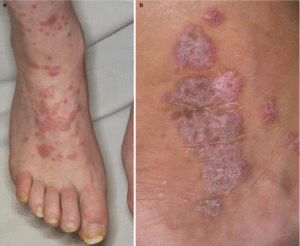Is an inflammatory autoimmune disease that affects the skin and mucous membranes. Cutaneous Lichen Planus presents with an itchy, non-infectious rash of small, pink, or purple lesions.
Lesions can come in varying forms from ring-shaped lesions to pigmentations or rashes. It can be associated with other skin conditions such as lupus or sclera derma.
Cutaneous Lichen Planus affects the skin, scalp, and nails, whereas the Mucosal Lichen Planus affects the inside lining of mucous membranes of the gastrointestinal tract, genitals, bladder, ears, nose, and eyes.
Unfortunately, this condition has no cure, so maintenance of the skin condition is controlled with medication, emollients, and other procedures. Thankfully is a rare condition that only affects 0.1 – 4% of people.
Causes of Cutaneous Lichen Planus:
- Thought to be a T- cell-mediated autoimmune reaction (where the body’s immune system targets its own cells), which leads to the death of the skin cells.
- Maybe stress-related.
Triggers may include:
- Drug reactions, (i.e. thiazide diuretics, gold salts, antimalarials, beta-blockers, furosemide, anti-inflammatory’s, metformin, spironolactone, and penicillamine).
- Mercury tooth fillings, where symptoms generally resolve with removal.
- Conditions such as hepatitis, (specifically hep B and C infection), and primary biliary cirrhosis.
 Symptoms of Cutaneous Lichen Planus:
Symptoms of Cutaneous Lichen Planus:
- A rash appears abruptly, with the first outbreak usually lasting weeks to months.
- When the rash has gone there may be dark brown/gray spots on the skin, which are more noticeable on dark skin.
- 10% of cases affect the nails, causing irregular longitudinal grooving, ridging, thinning, and shedding of the nail plate with tissue death of the nail bed.
- Hardening of skin under the nails and pigmentation may be evident.
- Lesions are approximately 3mm to 5mm in diameter.
- White streaks on the lesions called “Wickham’s striae” can be present.
- Intense itching, which is worse at night.
- The most affected areas are the wrists, elbows, lower back, and ankles.
- The shins present with thickened lichen planus.
- Scaly scalp and/or inflamed hair follicles.
- The condition may become worse with sunlight.
Diagnosis of Cutaneous Lichen Planus:
The diagnosis of Cutaneous Lichen Planus is clinically by the “lichen-like” appearance of the skin lesions. A biopsy can be used to rule out malignancies, and confirm the diagnosis.
Treatment for Cutaneous Lichen Planus:
- Corticosteroids and immunosuppressant topical ointment.
- Removal of any triggers.
- Oral corticosteroids – for severe cases.
- Antihistamines, mainly at night to help with itching.
- Cosmetic treatments may include laser surgery, cryotherapy, and phototherapy.
- Medication to lower the immune system, in severe cases.
The misdiagnosis of Lichen Planus is common, due to the condition’s rare nature. However, Well Heeled Podiatry is trained and skilled in diagnosing many conditions on the feet. If you have an unusual rash or concern on the feet, make sure you have it checked by a professional to get the right treatment plan.
Related Topics
- Eczema
- Cracked Heels
- Psoriasis
- Tinea Pedis


 Symptoms of Cutaneous Lichen Planus:
Symptoms of Cutaneous Lichen Planus: